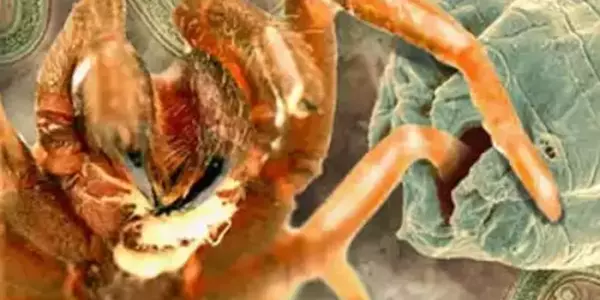A newly found species of worm that kills tarantulas have been named after American actor, musician, and producer Jeff Daniels, a distinction no other entertainment can claim. Jeff Daniels has had a long and illustrious career, but no other actor has named a new species of parasitic tarantula-killing nematode after him.
These worms, known as nematodes, have over 25,000 recognized species and are one of the most abundant invertebrates on the planet. However, this is only the second time one has been discovered infecting tarantulas. Tarantobelus jeffdanielsi was named after Daniels’ character in the 1990 film Arachnophobia, who protects a village from a dangerous spider infestation.
“His role in the film is a spider killer, which is exactly what these nematodes are,” said Adler Dillman, a parasitologist at UC Riverside who led the research that found the nematode. “When I initially learned that a new species of nematode had been named after me, I wondered, ‘Why?’ ‘Is there a resemblance?’ Daniels joked to UCR. “To be honest, I was moved by their tribute to me and Arachnophobia. It made me happy. And, of course, you haven’t really made it in Hollywood until you’ve been recognized by people in the field of parasitology.”
Nematodes have been present for billions of years. They’ve evolved to infect every kind of host on the planet including humans. Any animal you can think of on the earth can be infected by a nematode.
Adler Dillman
The study of the team describing jeffdanielsi was just published in the Journal of Parasitology. A wholesale tarantula grower approached Dillman in September 2019 for assistance in discovering a mystery ailment in some of their tarantulas. Specimens received for examination had an unusual whitish mass around the mouth. Dillman, who teaches the sole parasitology course at UCR, immediately identified the white patches as worms.
Previously, European scientists detected the first nematodes found on tarantulas. However, that study only looked at the worms themselves, not the worms found on spiders. Tarantulas that have been afflicted begin to exhibit unusual behavior such as walking on tiptoe and not eating. The tarantula’s appendages that control its teeth also stop operating.
“Because tarantulas do not need to eat very frequently, it could take months. However, if they contract this infection, they will perish from famine” Dillman stated his case. Dillman’s team discovered how the worms multiply and where they live on the spiders, in addition to demonstrating that jeffdanielsi infection is fatal.

Jeffdanielsi are usually self-fertilizing hermaphrodites with their own sperm and eggs. According to Dillman, a single hermaphrodite can produce 160 babies in its lifetime. That lifespan is 11 days in the laboratory. It’s unclear how long they can survive on tarantulas.
The researchers also discovered that the nematodes only inhabited the mouth area; none were located in the stomach, and they did not appear to inflict any damage to the tarantulas’ exteriors. “It’s unclear if the nematodes eat the spider. It’s probable that they feed on bacteria found on tarantulas” Dillman stated his case. When the researchers developed the worms in the lab, they ate e. coli, proving that they are bacterium eaters in general.
One unsolved issue is how the nematodes modify the tarantulas’ behavior and paralyze their pedipalps, the organs that regulate their fangs. Dillman intends to conduct future research to better understand this phenomenon, as well as how breeders can treat or perhaps prevent jeffdanielsi illnesses.
Though detecting a tarantula parasite is uncommon, Dillman feels this reflects more on the amount of people who study tarantulas than the likely uniqueness of the nematodes that infect them.
“Nematodes have been present for billions of years. They’ve evolved to infect every kind of host on the planet including humans,” he said. “Any animal you can think of on the earth can be infected by a nematode.”
Nematodes are not a rare or novel form of organism. According to studies, nematodes have been present for millions of years and have been known to infect virtually any living entity, as well as exist in large quantities. They may live freely on their own, but they prefer to exist as parasites on plants and animals. Hookworms and pinworms are parasitic nematodes that live in humans.
There was just one nematode species known to infect tarantula spiders prior to this finding. However, rather than examining worms infecting a tarantula, research on this initial species focused solely on the worms themselves.
One aspect of the worms that remained a mystery to Dillman was how they were able to influence the tarantula’s behavior and prevent it from using its fangs. Dillman also plans to do additional research to find a potential treatment for diseased tarantulas.
















